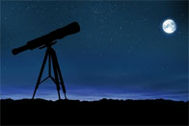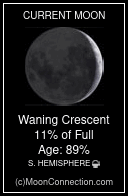| Magellanic Clouds |
Two small, irregular galaxies found just outside our own Milky Way galaxy. The Magellanic Clouds are visible in the skies of the southern hemisphere. |
| Magnetic Field |
A condition found in the region around a magnet or an electric current, characterized by the existence of a detectable magnetic force at every point in the region and by the existence of magnetic poles. |
| Magnetic Pole |
Either of two limited regions in a magnet at which the magnet's field is most intense. |
| Magnetosphere |
The area around a planet most affected by its magnetic field. The boundary of this field is set by the solar wind. |
| Magnitude |
The degree of brightness of a star or other object in the sky according to a scale on which the brightest star has a magnitude -1.4 and the faintest visible star has magnitude 6. Sometimes referred to as apparent magnitude. In this scale, each number is 2.5 times the brightness of the previous number. Thus a star with a magnitude of 1 is 100 times brighter than on with a visual magnitude of 6. |
| Magnitude |
The measure of apparent brightness of a celestial object. |
| Main Belt |
The area between Mars and Jupiter where most of the asteroids in our solar system are found. |
| Major Planet |
A name used to describe any planet that is considerably larger and more massive than the Earth, and contains large quantities of hydrogen and helium. Jupiter and Neptune are examples of major planets. |
| Mare |
A term used to describe a large, circular plain. The word mare means "sea". On the Moon, the maria are the smooth, dark-colored areas. |
| Mars |
4th planet |
| Mass |
A measure of the total amount of material in a body, defined either by the inertial properties of the body or by its gravitational influence on other bodies. |
| Matter |
A word used to describe anything that contains mass. |
| Mercury |
1st planet |
| Meridian |
An imaginary circle drawn through the North and South poles of the celestial equator. |
| Metal |
A term used by astronomers to describe all elements except hydrogen and helium, as in "the universe is composed of hydrogen, helium and traces of metals". This astronomical definition is quite different from the traditional chemistry definition of a metal. |
| Meteor |
A small particle of rock or dust that burns away in the Earth's atmosphere. Meteors are also referred to as shooting stars. |
| Meteor Shower |
An event where a large number of meteors enter the Earth's atmosphere from the same direction in space at nearly the same time. Most meteor showers take place when the Earth passes through the debris left behind by a comet. |
| Meteorite |
An object, usually a chunk or metal or rock, that survives entry through the atmosphere to reach the Earth's surface. Meteors become meteorites if they reach the ground. |
| Meteoroid |
A small, rocky object in orbit around the Sun, smaller than an asteroid. |
| Millibar |
A measure of atmospheric pressure equal to 1/1000 of a bar. Standard sea-level pressure on Earth is about 1013 millibars. |
| Minor Planet |
A term used since the 19th century to describe objects, such as asteroids, that are in orbit around the Sun but are not planets or comets. In 2006, the International Astronomical Union reclassified minor planets as either dwarf planets or small solar system bodies. |
| Molecular Cloud |
An interstellar cloud of molecular hydrogen containing trace amounts of other molecules such as carbon monoxide and ammonia. |

